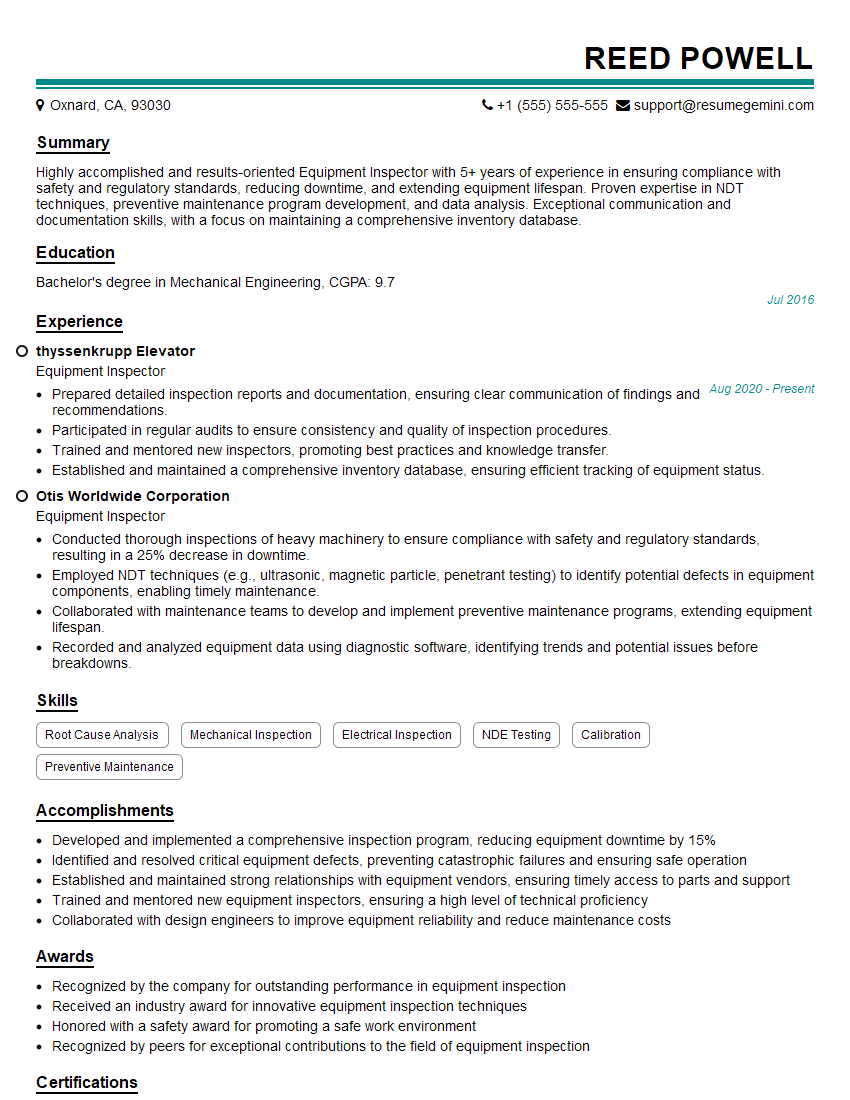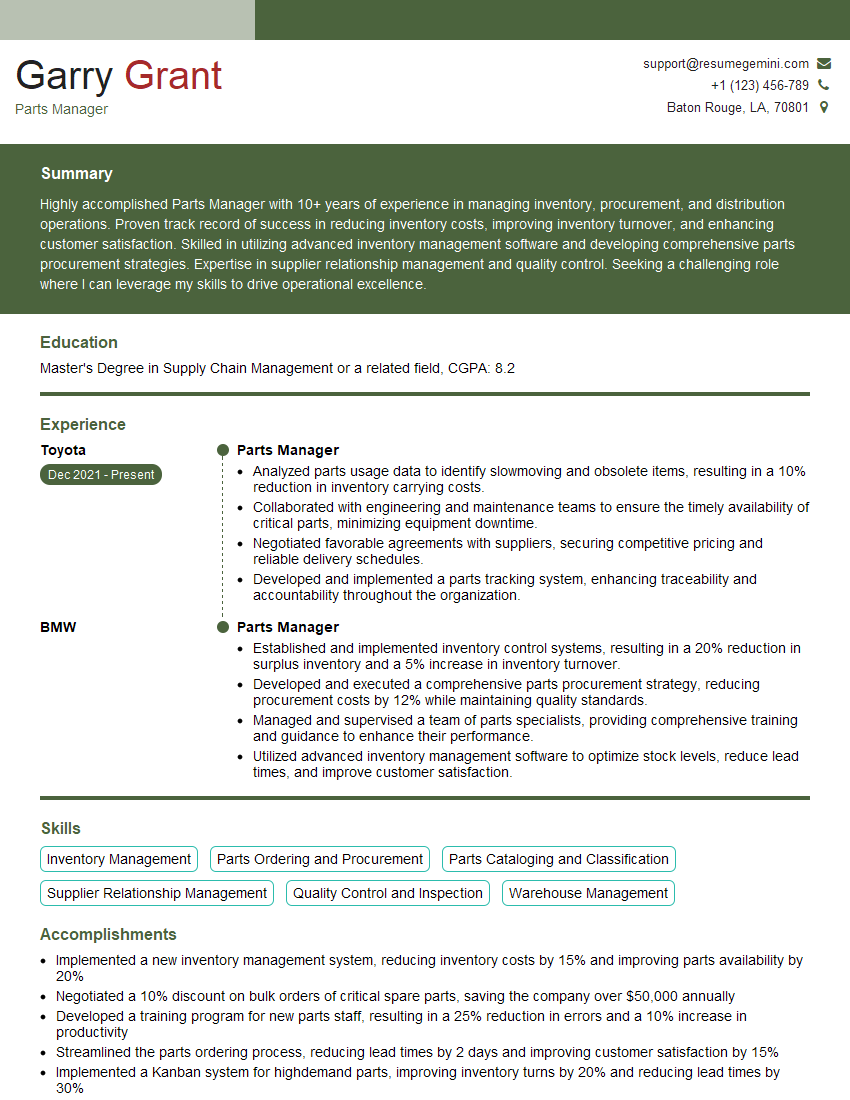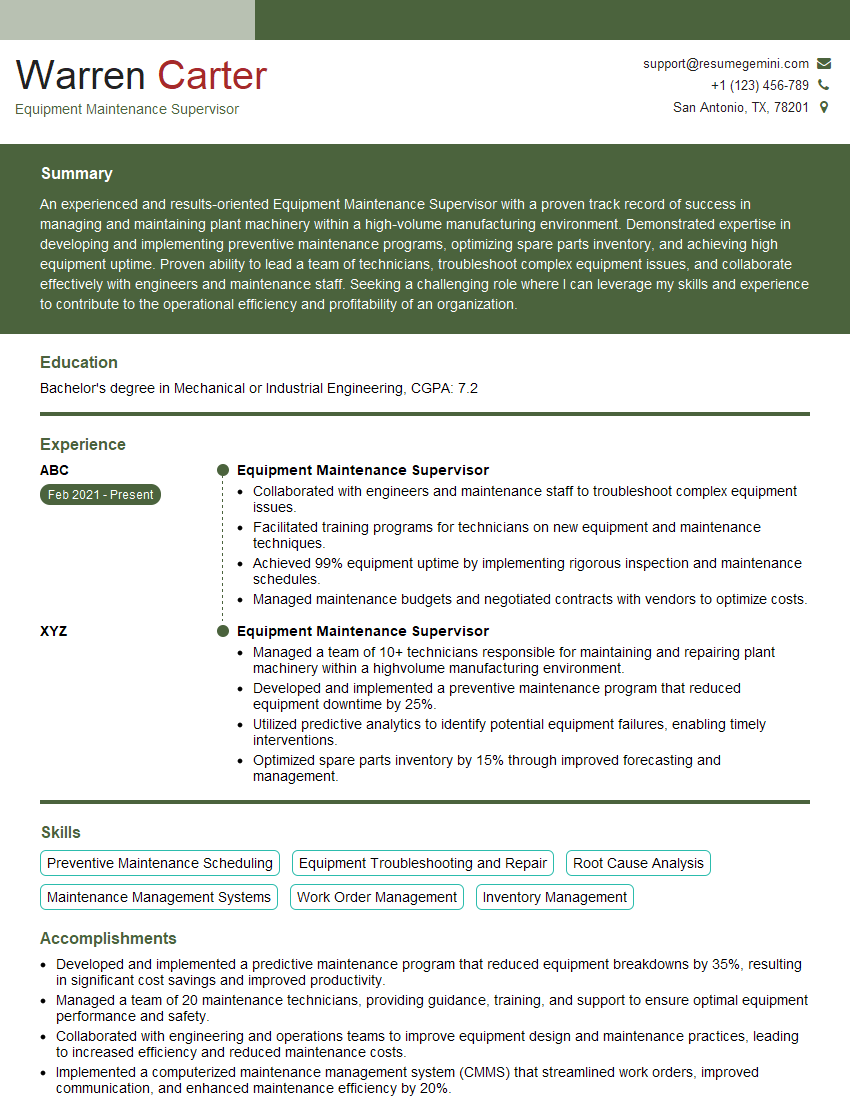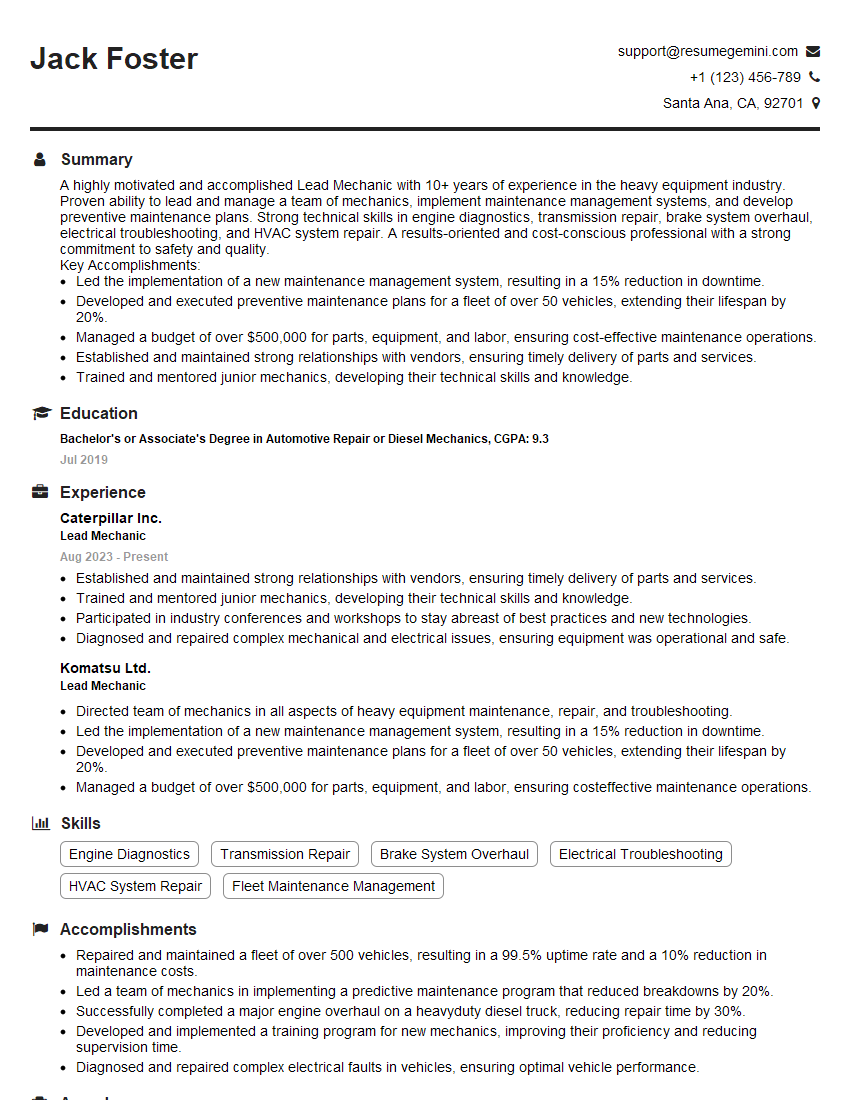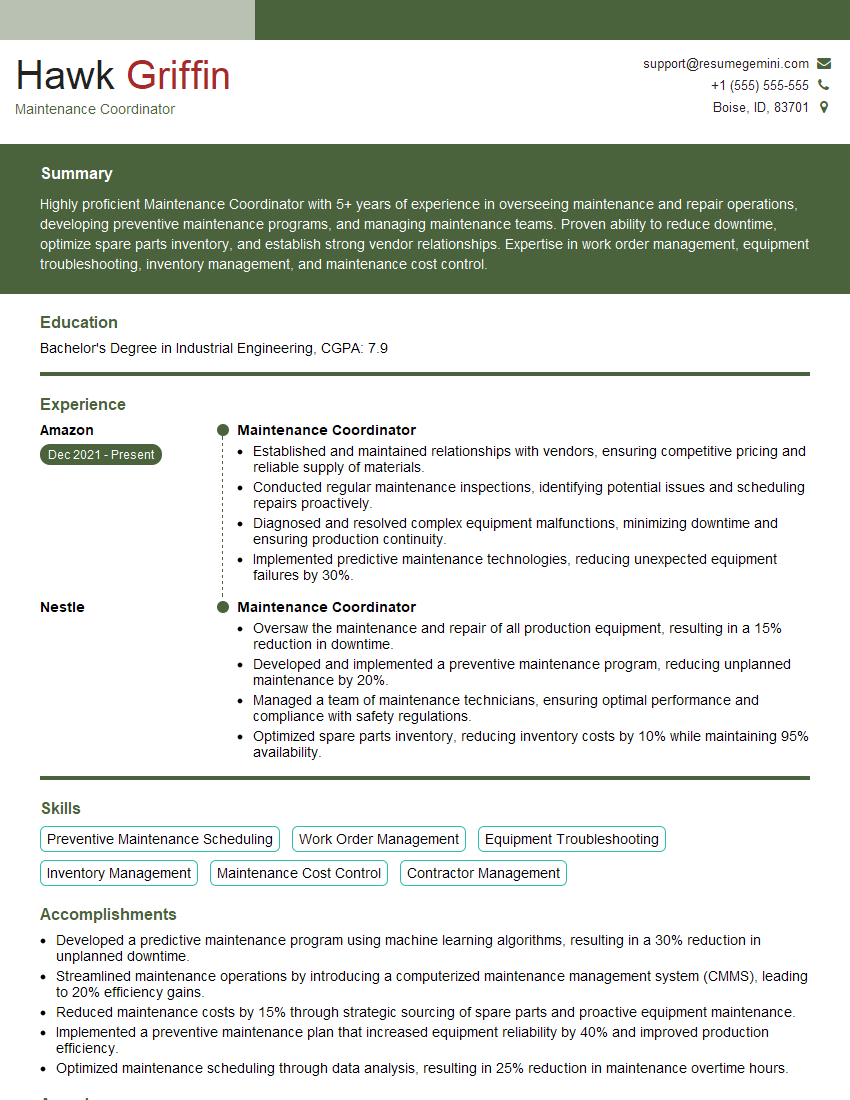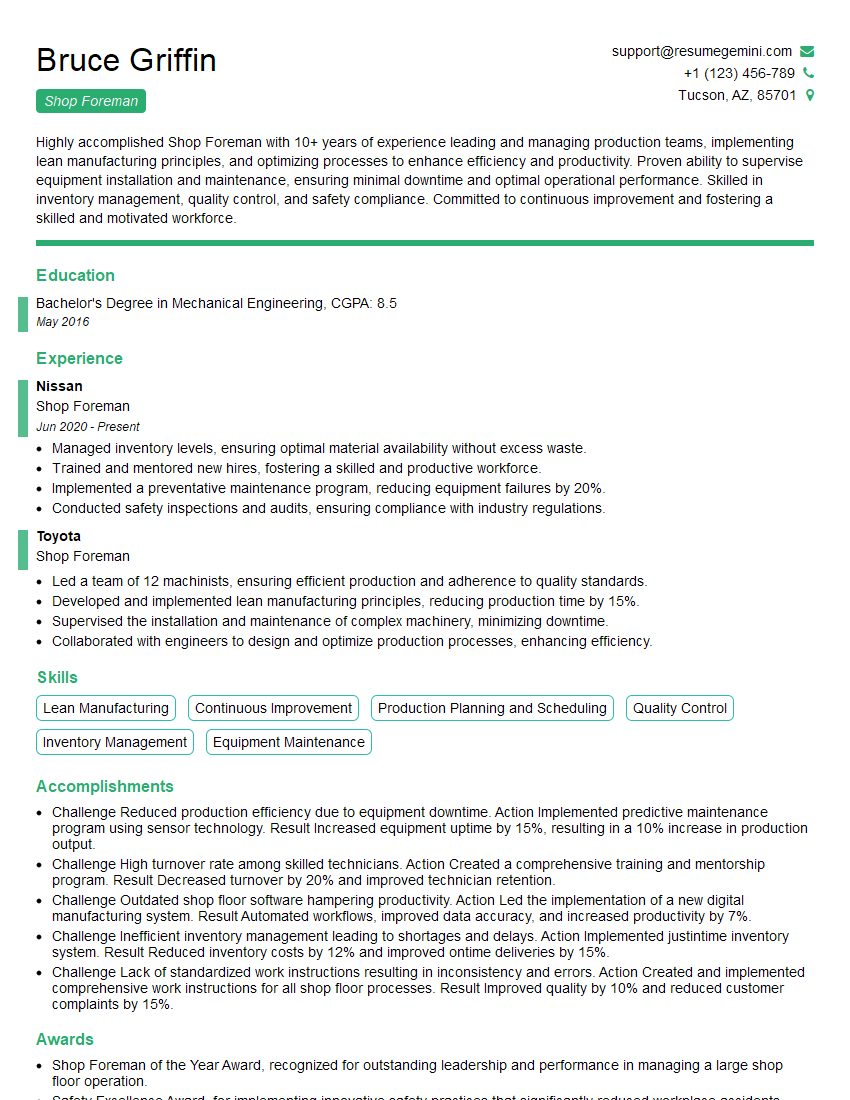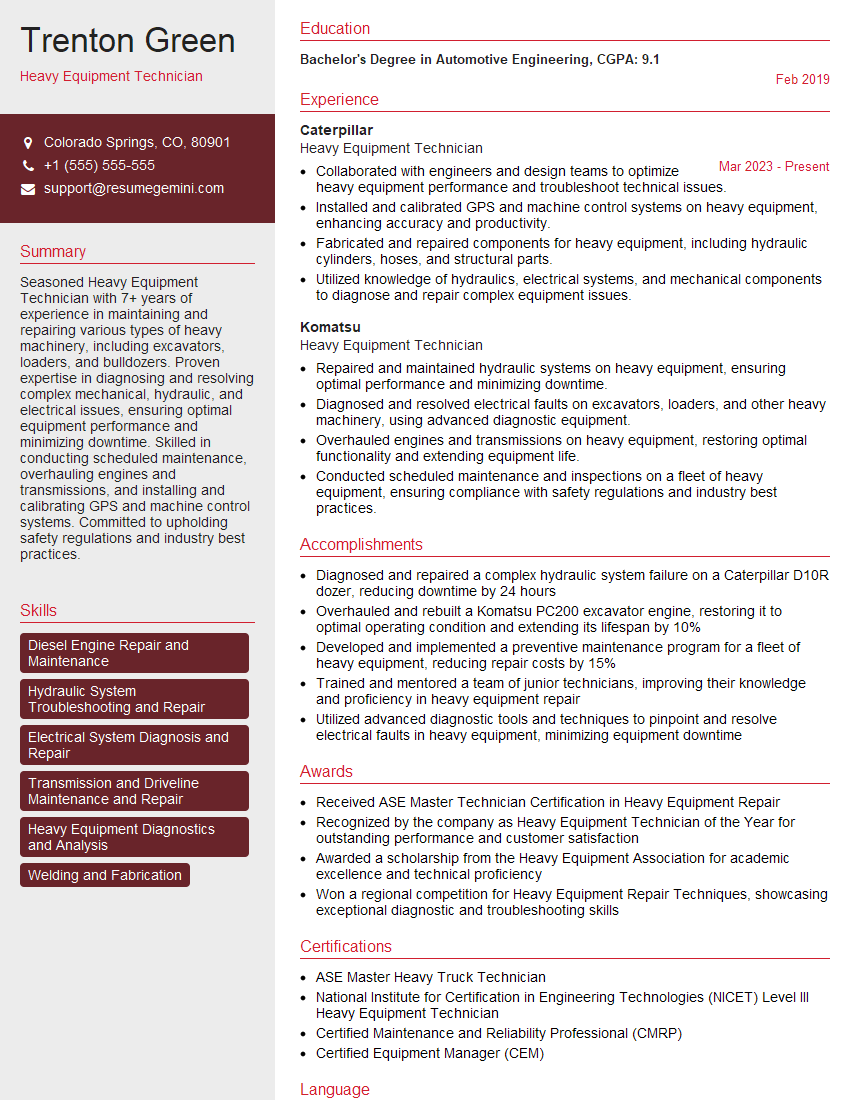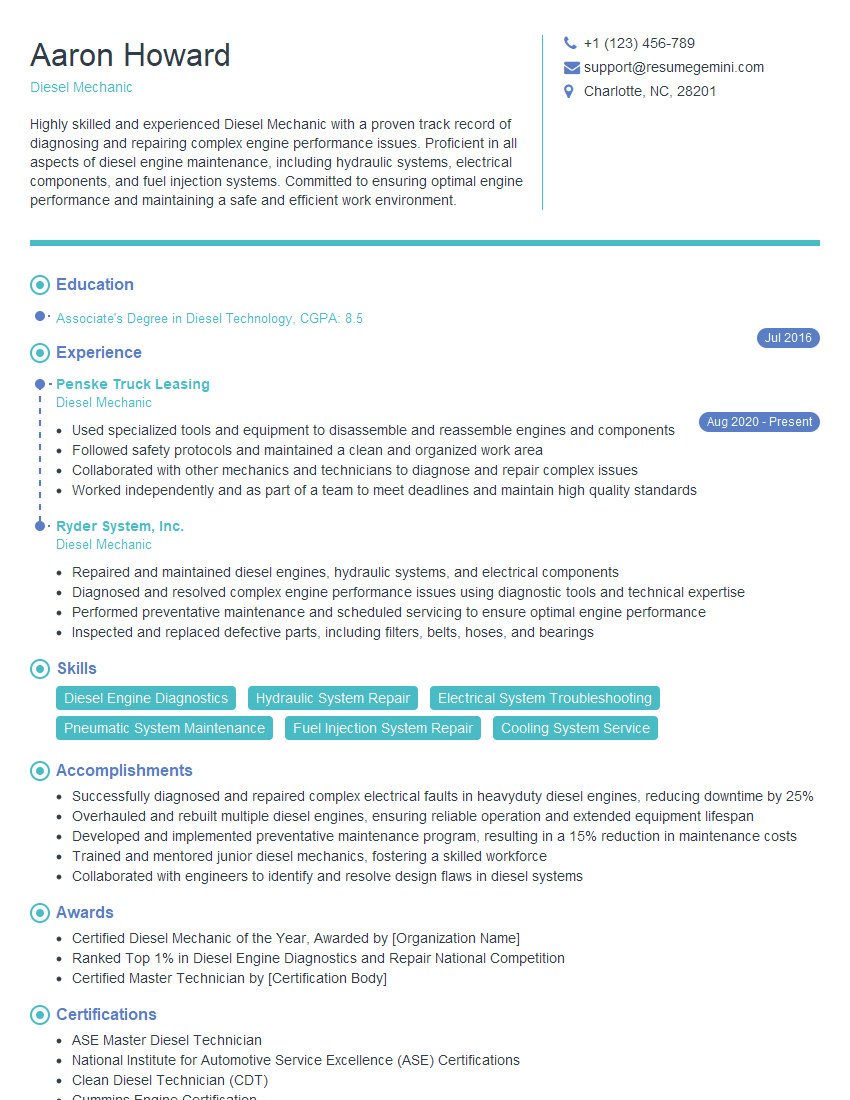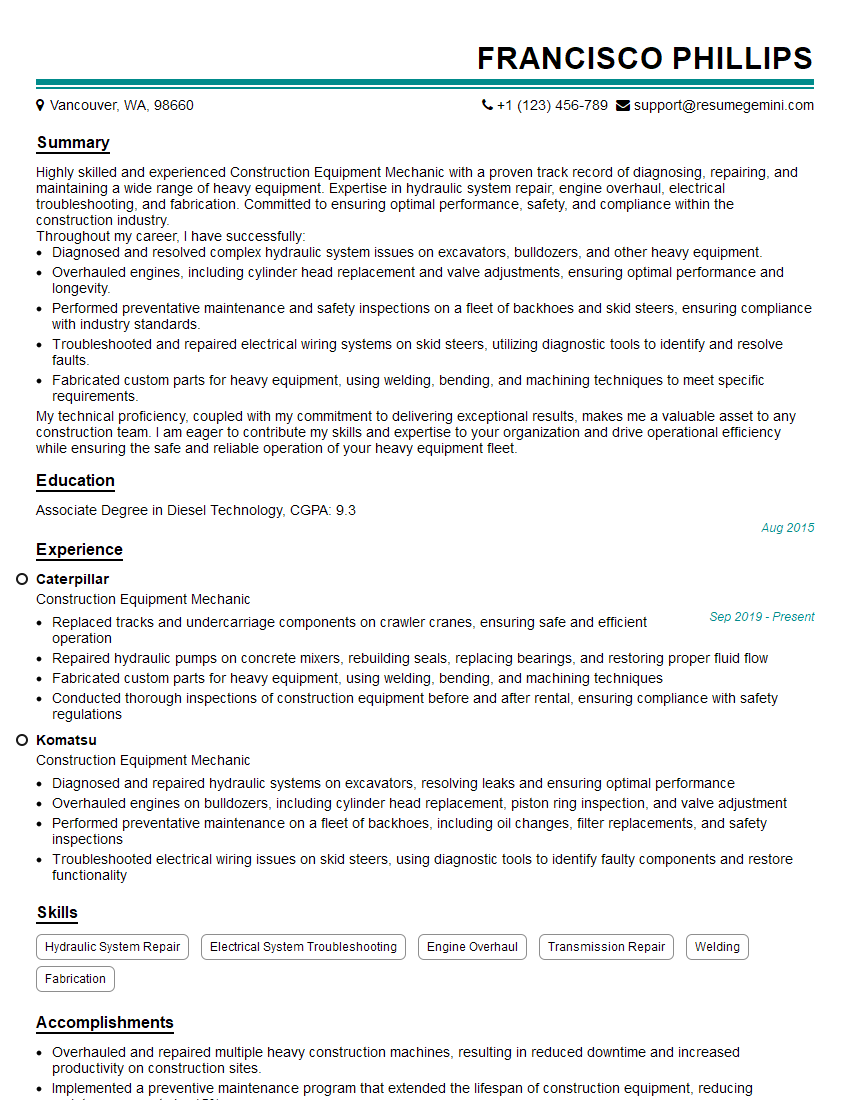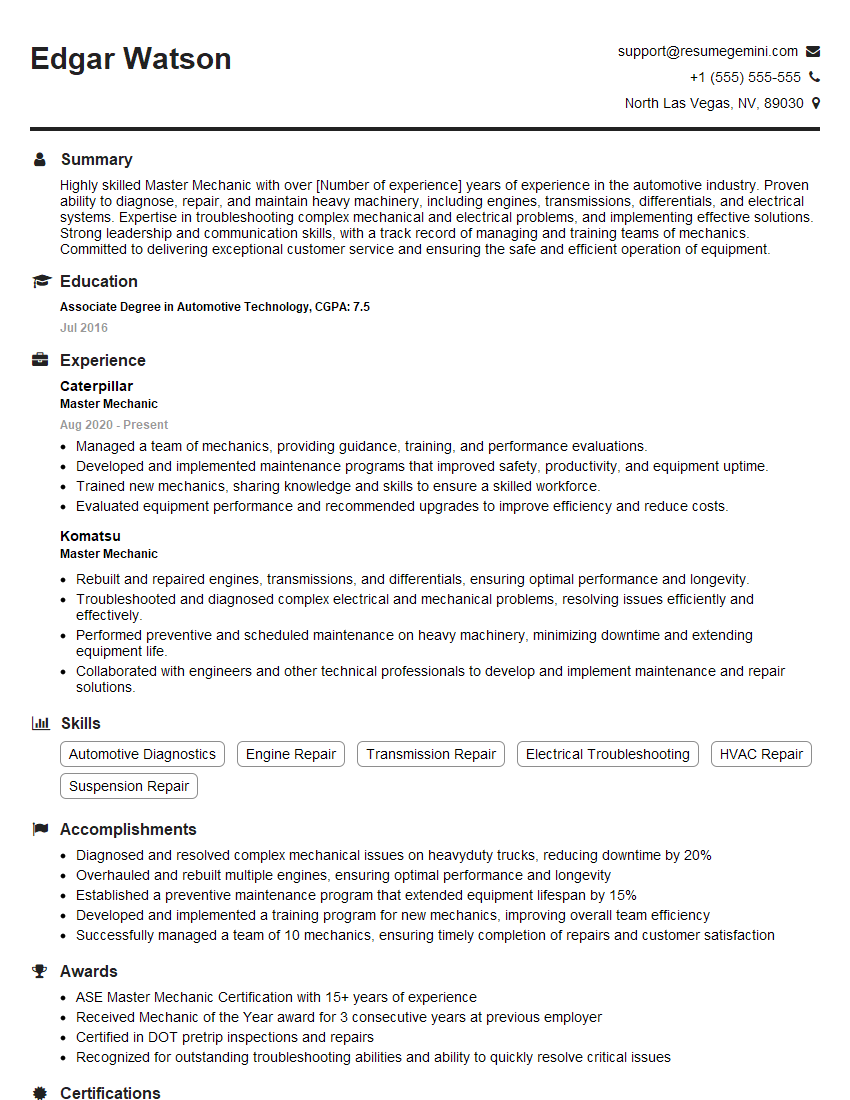The thought of an interview can be nerve-wracking, but the right preparation can make all the difference. Explore this comprehensive guide to Construction Equipment Maintenance and Repair interview questions and gain the confidence you need to showcase your abilities and secure the role.
Questions Asked in Construction Equipment Maintenance and Repair Interview
Q 1. Describe your experience with preventative maintenance schedules for heavy equipment.
Preventative maintenance (PM) schedules for heavy equipment are crucial for maximizing uptime and minimizing costly repairs. Think of it like regular checkups for your car – catching small issues before they become major problems. My experience involves developing and implementing PM schedules tailored to specific equipment types, operating conditions, and manufacturer recommendations. This includes creating a detailed checklist covering routine inspections, lubrication, fluid changes (engine oil, hydraulic fluid, transmission fluid, coolant), filter replacements, and component adjustments. For example, a crawler excavator’s PM schedule would differ significantly from a wheel loader’s, considering the unique stresses each machine endures. I utilize computerized maintenance management systems (CMMS) to track PM activities, generate work orders, and record historical data, allowing us to identify potential issues and refine our preventative measures over time. A well-structured PM schedule is key to predicting potential failures, extending equipment lifespan, and preventing catastrophic breakdowns on a job site.
- Example: For a hydraulic excavator, the PM schedule would include regular grease fittings inspections, cylinder leak checks, and boom swing checks at every 50 hours, a major service including fluid changes at every 500 hours, and more comprehensive checks every 2000 hours.
- Practical Application: Implementing a robust PM schedule reduces downtime by approximately 30-40%, minimizes repair costs by up to 50%, and substantially improves operational safety.
Q 2. Explain the process of diagnosing a malfunctioning hydraulic system.
Diagnosing a malfunctioning hydraulic system requires a systematic approach. Think of it like detective work – you need to gather clues to pinpoint the culprit. I start by observing the symptoms: Is there a complete loss of function, reduced power, leaks, unusual noises, overheating? Then, I visually inspect the system for obvious signs of damage, leaks, or loose connections. Next, I’ll check the hydraulic fluid level and condition. Is the fluid contaminated or low? Low fluid might indicate a leak, while contamination suggests internal component damage. I’ll then use diagnostic tools such as pressure gauges to measure system pressure, which helps to identify pressure drops indicating blockages, valve malfunctions, or pump problems. Temperature readings can indicate overheating, possibly due to insufficient cooling or internal friction. Further investigation might involve using flow meters to measure fluid flow rate, checking the hydraulic pump’s operation, testing the various valves and actuators, and eventually isolating the faulty component.
- Example: If an excavator’s bucket movement is sluggish, I might first check the hydraulic fluid level and condition. If normal, I would then check system pressure using a pressure gauge. Low pressure could point towards a pump failure, a restricted filter, or a faulty control valve. By systematically checking the different components, the exact problem can be identified.
Q 3. How do you troubleshoot electrical issues in construction equipment?
Troubleshooting electrical issues in construction equipment often involves a combination of systematic testing and a good understanding of electrical circuits. I begin by visually inspecting wiring harnesses, connectors, and components for obvious damage, loose connections, or corrosion. Then, I use a multimeter to check voltage, current, and continuity in different parts of the circuit, comparing measurements to the manufacturer’s specifications. A schematic diagram is essential for this process. I might also use specialized diagnostic tools like a wiring harness tester or an oscilloscope to isolate more complex problems. In addition to basic troubleshooting, it’s crucial to work safely with electrical systems and to fully understand safety measures.
- Example: If a machine’s lights don’t work, I would first check the fuse. If the fuse is blown, I would replace it and see if the problem is solved. If not, I’d use a multimeter to check the voltage at the light switch, then at the light itself. Low voltage indicates a wiring problem somewhere in the circuit.
- Safety First: Always disconnect power before working on electrical components. Using insulated tools and working with a partner are essential safety precautions.
Q 4. What are the common causes of engine overheating in diesel engines?
Engine overheating in diesel engines is a serious issue that can cause significant damage. The most common causes include issues with the cooling system (radiator, water pump, thermostat, coolant levels), clogged air filters restricting airflow, insufficient lubrication, malfunctioning fan or fan clutch causing insufficient cooling, and problems with the engine itself, such as blocked waterways or a faulty head gasket. Also, prolonged periods of operation under heavy load or in high ambient temperatures can contribute to overheating. Regular maintenance, such as coolant flushes and checks of the radiator’s condition and cooling fan, can significantly reduce the risk of overheating.
- Example: If the coolant level is low, it might indicate a leak in the radiator, hoses, or water pump. A malfunctioning thermostat could prevent the coolant from circulating properly, causing overheating.
Q 5. How do you perform a safety inspection on a piece of heavy equipment before operation?
A thorough safety inspection before operating any piece of heavy equipment is non-negotiable. Think of it as a pre-flight checklist for an airplane. My inspection follows a comprehensive checklist and always includes visual checks of the machine’s overall condition, tires and tracks for wear and damage, fluid levels (engine oil, hydraulic fluid, coolant, fuel), lights and signals, safety devices (seatbelts, emergency shut-off), and any obvious damage or leaks. I then check the functional aspects of the machine: brakes, steering, hydraulics, engine operation, and the stability of the equipment. Ensuring all safety systems are functioning correctly is paramount, as is verifying that all warning signs and lights are working correctly. Documentation is crucial; I record all findings in a pre-operational inspection report.
- Example: Before operating a forklift, I would check the condition of the forks, ensure the mast is free from damage and the forks are correctly aligned, check the brakes, horn and lights and visually inspect the surrounding environment for potential hazards.
Q 6. Describe your experience with repairing diesel fuel systems.
Repairing diesel fuel systems requires specialized knowledge and precision. My experience includes diagnosing and repairing issues such as fuel leaks, fuel pump failures, injector malfunctions, and problems with the fuel filters. I use diagnostic tools like pressure gauges and fuel flow meters to pinpoint the exact location of the problem. I’m familiar with different fuel injection systems and have experience working with various types of fuel pumps (mechanical, electric) and injectors. Cleanliness is paramount when working on fuel systems, as even small amounts of contamination can cause significant problems. I always follow proper safety procedures when handling fuel, as it is highly flammable.
- Example: If a diesel engine is experiencing hard starting or poor performance, I might check the fuel pressure using a pressure gauge. Low fuel pressure could indicate a problem with the fuel pump, clogged fuel filters, or a leak in the fuel lines.
Q 7. What are your skills in welding and fabrication related to equipment repair?
Welding and fabrication skills are essential for many repair tasks in construction equipment maintenance. My expertise includes both MIG and stick welding, enabling me to repair damaged components such as buckets, blades, and structural members. I have experience working with various metals, including steel and aluminum, and I can fabricate custom parts when necessary. This could range from creating simple brackets and mounting plates to more complex repairs that require precision and attention to detail. Safety is always a prime concern when working with welding equipment. I follow all necessary safety precautions, including wearing appropriate personal protective equipment (PPE).
- Example: I’ve repaired a damaged excavator bucket by cutting out the damaged section, fabricating a replacement using steel plate, and welding it back into place ensuring the strength and structural integrity.
Q 8. Explain your understanding of hydraulic system components and their functions.
Hydraulic systems are the lifeblood of many construction machines, powering everything from excavator arms to bulldozer blades. They rely on pressurized fluid to transmit power. Understanding their components is crucial for effective maintenance and repair.
- Reservoir: This tank stores the hydraulic fluid, keeping it clean and ready for use. Think of it as the heart of the system.
- Pump: The pump draws fluid from the reservoir and pressurizes it. It’s the engine of the system, creating the power.
- Control Valves: These valves direct the flow of pressurized fluid to different actuators, controlling the movement of the equipment. Imagine them as traffic controllers, directing the flow of power.
- Actuators (Cylinders): These convert hydraulic pressure into linear motion (pushing or pulling). They’re the muscles of the system, doing the heavy lifting.
- Hydraulic Motors: These convert hydraulic pressure into rotary motion. You find these in things like rotating parts on excavators.
- Filters: These remove contaminants from the hydraulic fluid, preventing damage to sensitive components. They’re the system’s kidneys, keeping it clean.
- Lines and Hoses: These transport the hydraulic fluid throughout the system. They are the veins and arteries.
For example, in an excavator, the control valve directs pressurized fluid to the cylinder that extends the arm. A malfunctioning valve could result in the arm not extending or moving erratically, highlighting the importance of understanding each component’s function.
Q 9. How do you interpret and utilize technical manuals and schematics?
Technical manuals and schematics are my bible. They provide the roadmap for understanding a machine’s intricate workings. I use them systematically:
- Identify the Problem: I start by pinpointing the issue – a faulty component, unusual noise, or performance degradation.
- Locate Relevant Sections: Using the manual’s index or table of contents, I quickly find diagrams and explanations related to the problem area. Schematics visually represent the system’s layout, showing how components interconnect.
- Interpret Diagrams: I carefully study wiring diagrams, hydraulic schematics, and exploded views to trace the flow of power, fluid, or signals. Understanding symbols and notations is essential here.
- Follow Troubleshooting Procedures: Many manuals include troubleshooting sections with step-by-step guides. I follow these procedures meticulously, checking components and connections.
- Cross-Reference Information: Sometimes I need to cross-reference information across different sections of the manual or consult supplemental materials like service bulletins.
For instance, if a hydraulic cylinder isn’t working, I’ll use the schematic to trace the fluid path from the pump to the cylinder, checking valves, hoses, and lines for leaks or blockages along the way. The manual will guide me on how to test the pressure at different points in the system.
Q 10. What experience do you have with different types of construction equipment (e.g., excavators, loaders, bulldozers)?
My experience spans a wide range of construction equipment. I’ve worked extensively on:
- Excavators: I’m proficient in maintaining and repairing both hydraulic and mechanical systems, including swing motors, travel motors, and bucket cylinders.
- Loaders: I’m familiar with various loader types, from wheel loaders to skid steers, and experienced with engine maintenance, transmission repairs, and hydraulic system diagnostics.
- Bulldozers: My expertise includes maintaining their tracks, undercarriage components, and blade systems, along with engine diagnostics and repairs.
- Other Equipment: I also have experience with cranes, backhoes, and graders, giving me a well-rounded understanding of various construction equipment types.
I can confidently troubleshoot and repair these machines, ensuring optimal performance and safety. For example, I recently diagnosed a faulty hydraulic pump on a wheel loader by carefully listening to the pump’s sound, checking its pressure, and referencing the technical manual’s troubleshooting section. The knowledge gained from working on diverse machinery has broadened my skills and problem-solving ability.
Q 11. Describe your experience with diagnosing and repairing engine problems.
Engine diagnostics and repair are a significant part of my skillset. I approach engine problems systematically, starting with a thorough inspection.
- Visual Inspection: I begin by visually inspecting for obvious problems like leaks, loose connections, or damaged components.
- Diagnostic Tools: I use diagnostic tools such as code readers and pressure gauges to pinpoint underlying issues. For example, a code reader can identify fault codes indicating sensor malfunction or fuel injection problems.
- Compression Test: A compression test assesses the engine’s ability to compress air, helping identify problems with rings, valves, or head gasket.
- Fuel System Check: I check the fuel system for blockages, leaks, or low fuel pressure.
- Electrical System Check: I check the electrical system for issues such as faulty sensors, wiring problems, or starter malfunctions.
I remember one instance where a bulldozer’s engine was misfiring. Using a code reader, I identified a faulty oxygen sensor. Replacing the sensor resolved the issue, restoring the engine’s performance. This shows how diagnostic tools can significantly streamline troubleshooting.
Q 12. How do you handle emergency repairs in the field?
Emergency repairs in the field demand quick thinking and resourcefulness. My approach is:
- Assess the Situation: First, I determine the severity of the problem and the potential safety risks. Is the equipment causing a hazard? Can it be safely moved?
- Prioritize Safety: Safety always comes first. I make sure the area is secure, using warning signs and other safety measures.
- Temporary Fix: I focus on implementing a temporary fix to restore functionality, allowing the equipment to be moved to a safer location for proper repair.
- Documentation: I meticulously document the issue, the temporary fix, and any additional steps taken. This is crucial for follow-up repairs.
- Communication: I maintain clear communication with my supervisor or team to update them on the situation and the steps being taken.
Once, an excavator’s hydraulic line ruptured in a remote location. After securing the area, I used a temporary clamp to stop the leak, allowing the operator to carefully move the excavator to a workshop for proper repairs. A temporary fix prevented further damage and ensured safety.
Q 13. What safety procedures do you follow while performing maintenance and repairs?
Safety is paramount in construction equipment maintenance. My adherence to safety procedures includes:
- Lockout/Tagout (LOTO): I always use LOTO procedures to isolate power sources before commencing any repair, preventing accidental starts.
- Personal Protective Equipment (PPE): I consistently wear appropriate PPE, such as safety glasses, gloves, hearing protection, and steel-toed boots.
- Environmental Awareness: I’m aware of environmental hazards and take precautions to prevent spills and protect the environment.
- Proper Lifting Techniques: I use appropriate lifting techniques and equipment to prevent injuries.
- Tool Safety: I ensure that all tools are in good condition and properly maintained.
- Fire Safety: I am aware of potential fire hazards, especially around fuel and hydraulic systems, and take the necessary precautions.
Following these procedures not only protects me but also contributes to a safe work environment for everyone on the site.
Q 14. Explain your experience with using diagnostic tools and equipment.
I’m proficient in using a variety of diagnostic tools and equipment. This includes:
- Engine Diagnostic Scanners: These tools read diagnostic trouble codes (DTCs) from engine control modules, pinpointing malfunctions.
- Hydraulic Pressure Gauges: These measure hydraulic pressure at various points in the system, helping diagnose leaks and malfunctions.
- Multimeters: I use multimeters to test electrical circuits and components.
- Infrared (IR) Thermometers: These help detect overheating components, often an early indicator of a problem.
- Specialized Testing Equipment: Depending on the situation, I may use more specialized equipment, such as fuel pressure testers, injector testers, or component testers.
My experience using these tools, coupled with my knowledge of the equipment and technical manuals, allows for efficient and accurate diagnosis and repair. Using an IR thermometer to detect an overheating hydraulic motor before it fails is a prime example of how diagnostic tools enable preventative maintenance.
Q 15. How do you manage your workload and prioritize tasks efficiently?
Effective workload management is crucial in construction equipment maintenance. I utilize a combination of techniques, starting with a prioritized task list. This list isn’t just a random collection; I categorize tasks based on urgency and importance using a system like the Eisenhower Matrix (urgent/important, important/not urgent, etc.). For instance, a critical engine malfunction on a primary excavator takes precedence over a minor dent repair on a backup bulldozer. I also leverage scheduling software to allocate time slots, accounting for potential delays and unexpected repairs. Regular review and adjustment of this schedule, factoring in team availability and resource allocation, ensure that everything stays on track. Finally, proactive communication with supervisors and colleagues keeps everyone informed and prevents bottlenecks.
Think of it like conducting an orchestra: each instrument (task) has its own part, and the conductor (me) ensures harmony and efficiency. I’m adept at recognizing when adjustments are needed, whether it’s reassigning a task or requesting additional resources.
Career Expert Tips:
- Ace those interviews! Prepare effectively by reviewing the Top 50 Most Common Interview Questions on ResumeGemini.
- Navigate your job search with confidence! Explore a wide range of Career Tips on ResumeGemini. Learn about common challenges and recommendations to overcome them.
- Craft the perfect resume! Master the Art of Resume Writing with ResumeGemini’s guide. Showcase your unique qualifications and achievements effectively.
- Don’t miss out on holiday savings! Build your dream resume with ResumeGemini’s ATS optimized templates.
Q 16. Describe your experience with different types of lubricants and their applications.
My experience spans a wide range of lubricants, from engine oils (conventional, synthetic, and high-mileage) to gear oils (hypoid, EP), greases (lithium, calcium, molybdenum disulfide), and hydraulic fluids (mineral-based, synthetic, and biodegradable). Selecting the right lubricant is critical; using the wrong one can lead to premature wear, component failure, and costly repairs. For instance, using a low-viscosity engine oil in a high-temperature environment could lead to excessive engine wear. Conversely, using a high-viscosity oil in cold weather can hinder engine starting and lubrication.
I understand the different viscosity grades (e.g., SAE 10W-30, 15W-40), their implications for various operating temperatures, and the importance of adhering to manufacturers’ recommendations. I’m also familiar with lubricant additives, such as anti-wear agents, detergents, and corrosion inhibitors, and how they enhance performance and extend the life of equipment. Regular lubricant analysis helps identify potential issues before they escalate into major problems – a crucial proactive maintenance measure.
Q 17. What is your experience with engine rebuilds or overhauls?
I have extensive experience with engine rebuilds and overhauls, including both diesel and gasoline engines. This involves a systematic process, starting with a thorough inspection to identify the extent of the damage. Then comes disassembly, cleaning, and inspection of each component – pistons, rings, connecting rods, crankshaft, bearings, etc. Worn or damaged parts are replaced, and precise measurements are taken to ensure proper clearances. After reassembly, the engine is rigorously tested to verify functionality and performance. During one project, we completely overhauled a large diesel engine on a heavy-duty earthmover, extending its operational life significantly.
A critical aspect is meticulous record-keeping: documenting every step of the process, including part numbers, measurements, and any anomalies encountered. This detailed record is essential for troubleshooting and future maintenance. It’s like a detailed medical chart for the engine; the more information you have, the better equipped you are to provide the right care.
Q 18. How familiar are you with different types of transmissions and their maintenance?
I’m familiar with various transmission types, including manual, automatic, and hydrostatic transmissions. Each type requires a specific maintenance approach. Manual transmissions, for example, require regular gear oil changes and adjustments, while automatic transmissions need fluid and filter changes, along with careful monitoring of fluid condition. Hydrostatic transmissions demand more specialized knowledge, involving careful checks of fluid levels, pressure, and temperature, as well as understanding the hydraulic system’s components.
Understanding transmission operation is key. A problem might manifest as sluggish shifting, strange noises, or even complete failure. Troubleshooting requires a systematic approach, starting with visual inspections, checking fluid levels and condition, and listening for unusual sounds. Advanced diagnostic tools are sometimes necessary to pinpoint the source of a malfunction. For instance, I once diagnosed a faulty torque converter in an automatic transmission by analyzing the fluid pressure readings, saving considerable time and expense compared to a trial-and-error approach.
Q 19. Describe your experience with repairing or replacing hydraulic cylinders and pumps.
Repairing and replacing hydraulic cylinders and pumps is a routine part of my work. It involves understanding the hydraulic system’s principles, including pressure, flow, and fluid properties. Cylinder repairs often involve replacing seals, bushings, or rods, requiring specialized tools and precision measurements to ensure proper function and prevent leaks. Pump repairs can be more complex, potentially involving replacing worn components like vanes, gears, or pistons. Accurate diagnosis is critical here to avoid unnecessary component replacement. For example, a seemingly faulty cylinder may in fact indicate a problem within the hydraulic pump itself.
Safety is paramount. Hydraulic systems operate under high pressure, posing a potential hazard. Proper safety procedures, including depressurizing the system before commencing any repairs, are always followed. I’ve handled numerous instances where precise repair and replacement of these components restored equipment to full operational efficiency.
Q 20. What is your experience with working on electrical systems (alternators, starters, wiring)?
My experience with electrical systems encompasses troubleshooting and repairing alternators, starters, wiring harnesses, and other electrical components. This involves using diagnostic tools such as multimeters, and specialized equipment for testing components. Troubleshooting electrical problems often requires a systematic approach, starting with visual inspections to check for obvious damage, loose connections, or corrosion. I’m adept at using wiring diagrams to trace circuits and identify faulty components. I often use a multimeter to check for voltage, current, and resistance, enabling me to isolate the fault swiftly.
For instance, I once resolved a persistent starting problem on a piece of equipment by tracing a faulty ground wire. This simple repair, which was easy to overlook without proper diagnostics, prevented a major equipment shutdown. Safe handling of electrical systems, awareness of voltage levels, and proper insulation techniques are critical to avoid electrical hazards. This isn’t just about repairing equipment – it’s about ensuring the safety of the workers who operate it.
Q 21. How familiar are you with different types of brakes and braking systems?
I’m familiar with various types of brakes, including disc brakes, drum brakes, and hydraulic brakes. Maintenance procedures vary depending on the type of brake system; disc brakes require periodic inspections of pad thickness and rotor condition, while drum brakes need adjustments and inspections of linings. Hydraulic brake systems require regular checks of fluid levels and condition, as well as attention to leaks and hose integrity.
Brake systems are safety-critical components, and their proper functioning is non-negotiable. A malfunctioning braking system can lead to serious accidents. Regular inspections, prompt repairs, and adhering to safety standards are paramount. I approach brake maintenance with extreme diligence, understanding that a seemingly minor issue can quickly escalate into a significant safety hazard. A clear understanding of how different braking systems function is paramount in order to provide safe and effective repairs.
Q 22. Describe your experience with troubleshooting and repairing cooling systems.
Troubleshooting and repairing cooling systems in construction equipment requires a systematic approach. It’s crucial to understand that these systems are vital for preventing overheating, which can lead to catastrophic engine failure. My experience encompasses diagnosing issues ranging from simple leaks to complex malfunctions involving radiators, water pumps, thermostats, and fans.
My troubleshooting process typically starts with a visual inspection, checking for obvious leaks, hose damage, or fan belt wear. I then use diagnostic tools like pressure testers to check for leaks in the radiator and hoses, and infrared thermometers to measure temperatures at various points in the system. This allows me to pinpoint the source of the problem quickly. For instance, a consistently high temperature at the radiator outlet with a functioning fan suggests a problem with the radiator itself or a blockage. If the issue is internal, like a faulty water pump, I’ll use specialized tools to assess its functionality. Finally, after identifying the faulty component, I perform the necessary repairs or replacements, always ensuring the system is properly bled and refilled with the correct coolant.
For example, I once worked on a grader where the engine was overheating. Initial inspection revealed no external leaks. Using an infrared thermometer, I identified a significantly higher temperature on one side of the radiator. Further investigation revealed a partially blocked core due to debris buildup. A thorough cleaning resolved the issue.
Q 23. How do you maintain accurate records of repairs and maintenance performed?
Maintaining accurate records is paramount for efficient equipment management and preventative maintenance. I utilize a combination of digital and paper-based methods. For each repair or maintenance task, I create a detailed record including the equipment ID, date, description of the work performed (including parts used with their serial numbers), labor hours, and any relevant observations. Digital records are kept in a CMMS (more on that in the next answer), and paper records are kept in organized files, cross-referenced with the digital system. This dual system offers redundancy and ensures data availability even during system outages.
For instance, if I replace a hydraulic hose on an excavator, my record will include the excavator’s identification number, the date of repair, the type and size of the hose replaced, the part number, and the technician’s initials. This level of detail allows for easy tracking of parts usage, maintenance costs, and performance history.
Q 24. What are your skills in using computerized maintenance management systems (CMMS)?
I’m proficient in using several CMMS (Computerized Maintenance Management Systems), including [mention specific CMMS, e.g., IBM Maximo, SAP PM]. My skills encompass data entry, work order generation, scheduling preventative maintenance, managing inventory, generating reports, and analyzing equipment performance data. A CMMS provides a centralized database for all equipment-related information, improving efficiency and reducing downtime. I understand how to use the system to track repair history, predict potential failures based on usage patterns, and optimize maintenance schedules.
For example, I can use a CMMS to set up automated reminders for routine maintenance tasks like oil changes or filter replacements, ensuring these crucial tasks are not overlooked. The system also allows me to generate reports showing maintenance costs over time, helping identify areas where optimization is needed.
Q 25. How do you identify and address potential safety hazards during equipment maintenance?
Safety is my top priority during equipment maintenance. My approach involves a thorough risk assessment before commencing any work. This includes identifying potential hazards like electrical shock, moving parts, high-pressure systems, and exposure to hazardous materials. I then implement appropriate control measures to mitigate these risks. These measures can include lockout/tagout procedures to isolate power sources, using personal protective equipment (PPE) such as safety glasses, gloves, and hearing protection, and ensuring proper ventilation in confined spaces.
I also emphasize regular tool inspections to ensure they are in good working order and regularly conduct site surveys to identify and eliminate tripping hazards. I’m trained in emergency procedures and know how to respond to various accidents or emergencies. For instance, before working on a hydraulic system, I would always ensure the system is depressurized and properly locked out to prevent accidental activation.
Q 26. Describe a time you had to troubleshoot a complex equipment problem. What was your approach?
One challenging situation involved a bulldozer experiencing intermittent engine stalling. Initial diagnostics pointed to various potential causes: fuel system, electrical system, or even a mechanical issue. My approach involved a systematic process of elimination. I started with the simplest and most likely causes, focusing on the fuel system first. I checked the fuel filter, fuel lines, and fuel injectors. Finding no anomalies, I then moved to the electrical system, testing the battery, alternator, and various sensors. I meticulously checked wiring harnesses for any signs of damage or corrosion.
After a thorough investigation, I discovered a faulty crankshaft position sensor. This sensor is critical for the engine’s timing and its failure could cause intermittent stalling. Replacing the sensor immediately resolved the problem. This situation highlighted the importance of methodical troubleshooting, starting with simple checks and progressing to more complex investigations. The key was patience, careful observation, and the use of diagnostic tools.
Q 27. What is your experience with working on various makes and models of heavy equipment?
My experience encompasses a wide range of heavy equipment makes and models, including Caterpillar, Komatsu, John Deere, and Volvo. I have worked extensively on excavators, bulldozers, loaders, graders, and other types of construction equipment. This experience has provided me with a strong understanding of the mechanical, hydraulic, and electrical systems common across various brands. While specific components and designs vary between manufacturers, the underlying principles remain largely consistent. My knowledge is not limited to just one brand, but rather a comprehensive understanding of the various systems and components used in the industry.
This diverse experience allows me to readily adapt to new equipment and efficiently diagnose and repair problems regardless of the manufacturer. I have a strong understanding of the common challenges associated with different makes and models, and this enables me to complete repairs quickly and effectively.
Q 28. Explain your understanding of environmental regulations related to equipment maintenance and disposal.
I have a strong understanding of environmental regulations related to equipment maintenance and disposal. This includes regulations concerning the handling, storage, and disposal of hazardous materials such as oil, hydraulic fluids, and refrigerants. I’m familiar with local, state, and federal regulations governing waste disposal and recycling. I ensure all maintenance activities comply with these regulations and follow proper procedures for handling and disposing of hazardous waste.
For instance, I’m well-versed in the procedures for properly draining and recycling used engine oil, ensuring it is not disposed of in a manner that could harm the environment. I’m also familiar with the regulations concerning the disposal of refrigerants used in air conditioning systems, and I adhere to the established procedures for their safe removal and recycling. I am trained to work responsibly and minimize the environmental impact of my work.
Key Topics to Learn for Construction Equipment Maintenance and Repair Interview
- Hydraulic Systems: Understanding hydraulic components (pumps, valves, cylinders), troubleshooting hydraulic leaks and malfunctions, and performing preventative maintenance.
- Engine Diagnostics and Repair: Diagnosing engine problems (e.g., starting issues, poor performance), performing engine tune-ups, and understanding various engine types (diesel, gasoline).
- Electrical Systems: Troubleshooting electrical faults, working with wiring diagrams, understanding battery systems and charging, and repairing electrical components.
- Safety Procedures and Regulations: Demonstrating knowledge of OSHA regulations, lockout/tagout procedures, and safe work practices for heavy machinery.
- Preventive Maintenance Schedules: Understanding the importance of preventative maintenance, creating and following maintenance schedules, and using maintenance logs effectively.
- Welding and Fabrication: Basic welding techniques for repairs, understanding different welding processes, and using fabrication tools to create or repair parts.
- Diagnostic Tools and Equipment: Proficiency in using diagnostic tools (e.g., multimeters, pressure gauges, diagnostic scanners) to identify and resolve issues.
- Troubleshooting and Problem-Solving: Demonstrating a systematic approach to troubleshooting, using logic and critical thinking to diagnose and repair complex equipment malfunctions.
- Specific Equipment Knowledge: Highlighting experience with specific types of construction equipment (e.g., excavators, bulldozers, loaders) and their unique maintenance requirements.
- Understanding of Blueprints and Schematics: Ability to interpret technical drawings and schematics to understand equipment design and perform repairs accurately.
Next Steps
Mastering Construction Equipment Maintenance and Repair opens doors to a rewarding career with excellent growth potential. Advancement opportunities abound for skilled technicians who are continuously learning and adapting to new technologies. To maximize your job prospects, crafting an ATS-friendly resume is crucial. ResumeGemini can significantly help you build a professional and impactful resume that highlights your skills and experience effectively. ResumeGemini provides examples of resumes tailored specifically to Construction Equipment Maintenance and Repair, allowing you to model your own based on best practices. Take this opportunity to elevate your resume and increase your chances of landing your dream job.
Explore more articles
Users Rating of Our Blogs
Share Your Experience
We value your feedback! Please rate our content and share your thoughts (optional).
What Readers Say About Our Blog
This was kind of a unique content I found around the specialized skills. Very helpful questions and good detailed answers.
Very Helpful blog, thank you Interviewgemini team.


